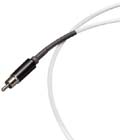A Tale of Three Cities
| A Tale of Three Cities |
|
Three Digital Interconnects |
|
Adnan Arduman |
|
10 August 2000 |
Kimber Illumination D-60: One meter $265.00
Kimber Select KS-2020: 0.75 meter (2.4’) RCA and/or BNC $580
Manufacturer: KIMBER KABLE
2752 South 1900 West
Ogden, Utah 84401
Tel: (801) 621-5530
Fax: (801) 627-6980
Web: www.kimber.com
Support and technical questions: support@kimber.com
Product literature requests: info@kimber.com
XLO Limited Edition: One meter $1,100.
Manufacturer: XLO Electric Company, Inc.
9480 Utica Avenue, Suite 612
Rancho Cucamonga, CA 91730
Tel: (800) 956 8721
Fax: (909) 466 3662
“My first impression was that all three cables were far superior in every respect to my existing Orelle and Wonder Link digital interconnects. It was clear that I was dealing with three top class cables.”
If you choose to use separate CD Transport and D/A Converter, then you will need to use a digital interconnect to link them together. I think one of the beauties of using separates is to be able to tune them to your own taste by trying different transports or DACs, and by trying different digital cables.
It is a fact that most audiophiles (including myself) have difficulties understanding or explaining the sonic differences of such cables that transmit only 0’s and 1’s. Every audiophile who has experimented with two different digital interconnects is aware of important sonic differences between them, but like most other magic tweaks its explanation belongs to the unquestioned “metaphysical” domain. Let me first briefly relate to you, in a very simplified manner, the “scientific” reasons behind the sonic differences of digital cables.
I should start by correcting myself: digital cables do not transmit 0’s (you don’t need a cable for that) but only 1’s. Think of 1’s as very narrow square waves of the same amplitude, starting and ending at the 0 axis. Sometimes they are juxtaposed and the narrow square wave becomes a relatively thicker one and other times separated from each other by a field of nothingness. Until here, we are in perfect agreement. “But any single conductor of any sort should do that without any problem,” you might say. Then I will very cleverly reply that the problem lies in the switching speed that can varies between 44kHz and 96kHz, depending on the software. Such frequencies involve transmission speed problems. Also it is claimed that even if the cable’s impedance is a true 75 ohms, the standard RCA plugs are not. Furthermore, the mating RCA jacks on the CD Transports and D/A converters are not 75 ohms either–by a wide margin! Such impedance mismatches at both ends cause jitter and reflections.
The reflected waves (1’s) from the end of the cable are of the opposite sign and are coming back towards the start of the cable. If the cable is not long enough to attenuate these reflections they may meet the incoming ones and cancel some of them. Thus, some of the 1’s are becoming 0’s–a wider field of nothingness. In the analog sense this is simply called distortion. Just for this reason some manufacturers don’t suggest using digital cables shorter than 1.5 m.
Jitter is a different issue, which has been largely covered in many different articles, so I will not bore you by trying to describe it here. It is clear that the quantity and the speed of the transmitted 1’s differ from cable to cable (there wouldn’t be sonic differences otherwise). The shape of the digital signal reaching the converter is never (exactly) the same as the one represented by holes and bosses on the silver disc. No cable is perfect, but some are close.
Technical Details
Kimber Illumination D-60 It features a unique pure silver conductor contained in an air-articulated Teflon dielectric with twin, helically wound shields to protect it from RF interference. The remaining layers and technology are proprietary. Termination options include BNC and RCA-type connectors. Composite, Component, RGB and RGB+HV formats are available. D-60 is sold in 0.5-meter increments and is only available factory terminated
It features a unique pure silver conductor contained in an air-articulated Teflon dielectric with twin, helically wound shields to protect it from RF interference. The remaining layers and technology are proprietary. Termination options include BNC and RCA-type connectors. Composite, Component, RGB and RGB+HV formats are available. D-60 is sold in 0.5-meter increments and is only available factory terminated
Kimber Select KS-2020 All conductors are made from Kimber’s Black Pearl silver (see my Kimber Select KS-1030 Interconnect review for details on Black Pearl Silver) and are insulated with dual-density V-Teflon dielectric material. Conductors are braided in a modified 75W MST geometry. MST technology was first developed for the Black Pearl loudspeaker cable. Over the modified MST cable Kimber braids a semi-conductive, non-metallic, electrostatic-dissipating (ESD) shell. Lastly, an esthetic and mechanically protective loose braid cover is applied. KS-2020 interconnects feature Kimber’s new proprietary termination technique. This new process/geometry is claimed to maintain the cable’s characteristic impedance all the way through the connection to nearly eliminate connection/termination reflections. Available in RCA-type and/or BNC, KS-2020 interconnects come in 0.75 meter, 1.0 meter, and 1.5-meter lengths. Kimber recommends the 0.75-meter length. Kimber to engraves the model and serial number, along with the signal flow indicator on eye-catching wood blocks of farmed Cocobola, attached to the end of the cable.
All conductors are made from Kimber’s Black Pearl silver (see my Kimber Select KS-1030 Interconnect review for details on Black Pearl Silver) and are insulated with dual-density V-Teflon dielectric material. Conductors are braided in a modified 75W MST geometry. MST technology was first developed for the Black Pearl loudspeaker cable. Over the modified MST cable Kimber braids a semi-conductive, non-metallic, electrostatic-dissipating (ESD) shell. Lastly, an esthetic and mechanically protective loose braid cover is applied. KS-2020 interconnects feature Kimber’s new proprietary termination technique. This new process/geometry is claimed to maintain the cable’s characteristic impedance all the way through the connection to nearly eliminate connection/termination reflections. Available in RCA-type and/or BNC, KS-2020 interconnects come in 0.75 meter, 1.0 meter, and 1.5-meter lengths. Kimber recommends the 0.75-meter length. Kimber to engraves the model and serial number, along with the signal flow indicator on eye-catching wood blocks of farmed Cocobola, attached to the end of the cable.
KIMBER indicates that the Select digital interconnects are not permanently directional. There is no electrodynamic asymmetry in the cable, including grounding. However, the manufacturing processes employed semi-permanently sets direction, and cannot be reversed or changed by the user. If the interconnect is used in the wrong direction it will not permanently affect the sound quality; it will simply need to be played in the correct direction for a few days to re-optimize its performance.
XLO Limited Edition Digital Cable Despite several attempts by Stereo Times’ editor, Frank Alles, and myself to obtain technical information on the XLO Limited Edition digital cable, we were unable to secure that information before publication.
Despite several attempts by Stereo Times’ editor, Frank Alles, and myself to obtain technical information on the XLO Limited Edition digital cable, we were unable to secure that information before publication.
Break-in
Virgin digital cables do not sound as bad as virgin analog interconnects. Break-in surely made a positive difference, but it was subtler than what I remembered for the analog interconnects—and the duration was shorter. Kimber’s recommendation is 150 hours for near complete break-in, compared to 250 hours for the analog interconnects. I think this is excellent news!
Listening and Subjective Evaluation
Because my digital gear includes the Genesis Digital Lens between CD Transport and DAC, I used one pair of each model to perform my comparisons. All three cables had RCA-type connectors. The CDs that I used for evaluation purposes were the following:
-
Berlioz: Symphonie Fantastique; RPO, Freccia (Chesky CD88)
-
Ahmad Jamal: The Essence Part 1; (Verve 314529327-2)
-
Mozart: Sonatas for Violin and Piano; Zimmermann, Lonquich (EMI CDC749712-2)
-
Shostakovich: Symphony No.8; Concertgebouw, Haitink (Decca 411616-2)
My first impression was that all three cables were far superior in every respect to my existing Orelle and Wonder Link digital interconnects. It was clear that I was dealing with three top class cables. Yet they were different from each other, each having their strengths and weaknesses.
Kimber Illumination D-60
Strong Points
This cable had the most natural tonality. The mids had just the right amount of body that suited acoustic instruments like violin and piano perfectly. The bass was extended and had weight and presence. The treble was of a silky nature, never becoming aggressive or bright. Cymbals sounded very natural. Overall it had an effortless, fluid, and involving sound. The key word to summarize its strength should bebalance.
Weak Points
It was the least detailed of the three cables, though only by a small margin. Also, its soundstage wasn’t as deep or as wide as the other two, and its bass was a shade less controlled.
Kimber Select KS-2020
Strong Points
This cable sounded very detailed and natural. It is definitely the most detailed of all three cables. The amount of inner detail it can resolve is truly amazing, and this without being hard or edgy. The instruments became very airy and alive. High frequencies were the most detailed and clean. They had a “see-through” clarity, yet never gave any hint of brightness and were non-fatiguing. The bass control was top class.
Weak Points
The tonal balance is slightly on the lean side.
XLO Limited Edition
Strong Points
The most impressive characteristic of this cable was its enormous stage width and depth. Tonally it was on the rich side. The midrange had body and the bass possessed tons of weight and extension. Its detail was very good, probably close to (but not matching) the Kimber Select 2020 in this respect.
Weak Points
Tonally it was not as natural/neutral as the two Kimbers. It gave a slight hint of coloration, which was especially apparent with acoustic instruments like violin and piano.
Conclusion
Which one to choose? I think the answer is very much case dependant, or I should say “synergy” dependent. If your system’s sonic character is on the rich side, then Kimber Select 2020 could be the right choice. If this is not the case and if you don’t mind the slight coloration (assuming that you are not a chamber music fan), then your choice could easily be XLO Limited Edition, which is a stunning cable otherwise. But if your first priority is natural tonality and therefore you do mind the slight coloration then you should go for Kimber Illumination D-60.
What would I choose for my own system regardless of price constraints? Well, it has been a tough decision but finally my vote went to the Kimber Illumination D-60. It sounded tonally correct in my system and still offered a very good sense of detail, effortlessly. And of course its price came as a bonus–I believe D-60 is the “best buy” of the lot. That said, I strongly recommend auditioning any of these fine cables in your own system.
![]()
Don’t forget to bookmark us! (CTRL-SHFT-D)
Stereo Times Masthead
Publisher/Founder
Clement Perry
Editor
Dave Thomas
Senior Editors
Frank Alles, Mike Girardi, Russell Lichter, Terry London, Moreno Mitchell, Paul Szabady, Bill Wells, Mike Wright, and Stephen Yan,
Current Contributors
David Abramson, Tim Barrall, Dave Allison, Ron Cook, Lewis Dardick, John Hoffman, Dan Secula, Don Shaulis, Greg Simmons, Eric Teh, Greg Voth, Richard Willie, Ed Van Winkle, Rob Dockery, Richard Doran, and Daveed Turek
Site Management Clement Perry
Ad Designer: Martin Perry





Be the first to comment on: A Tale of Three Cities